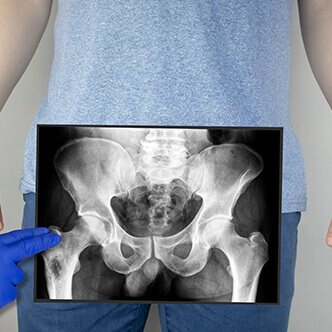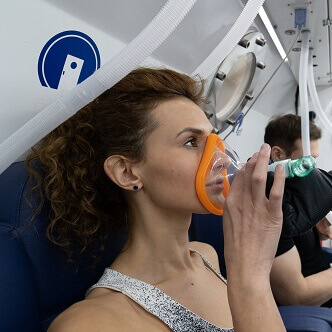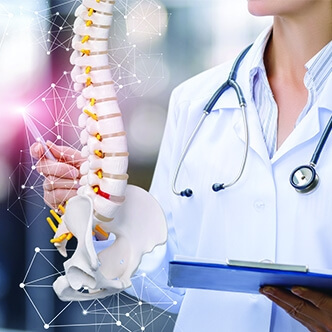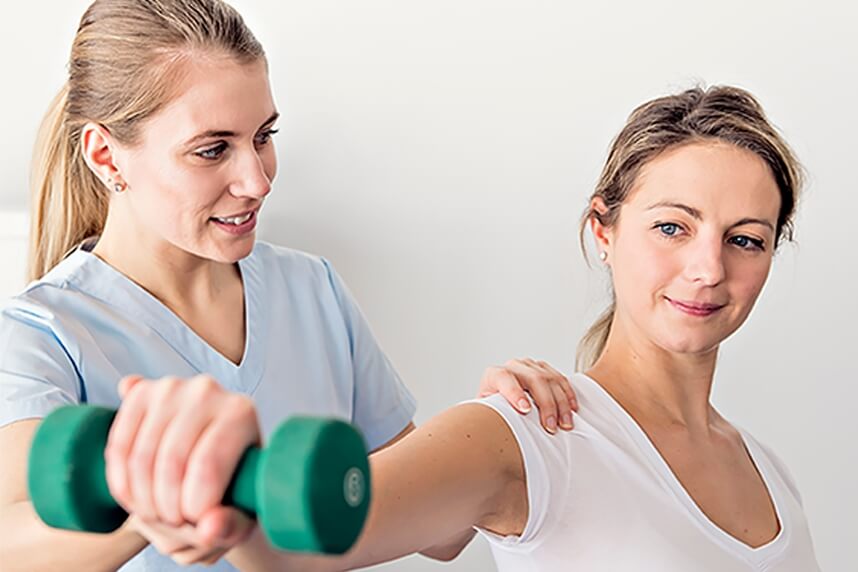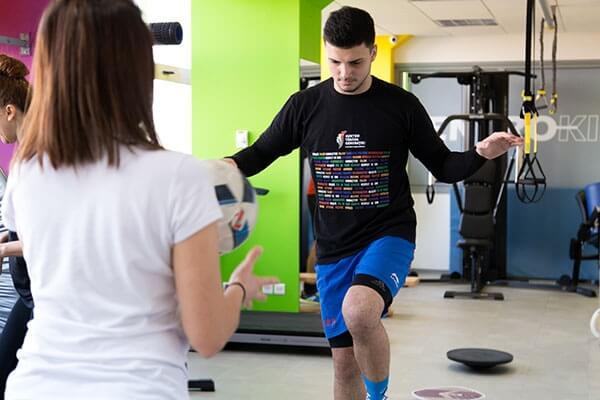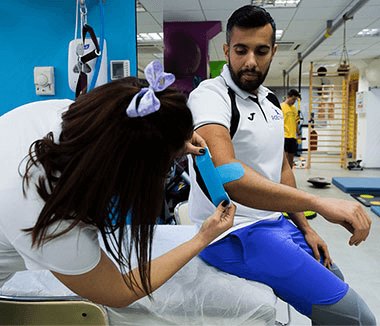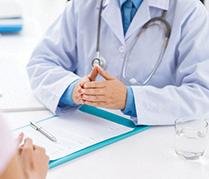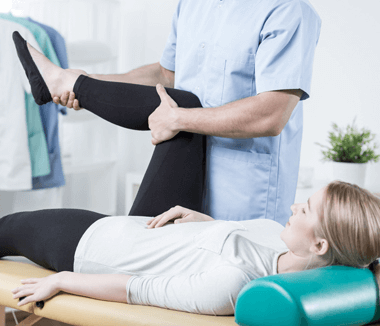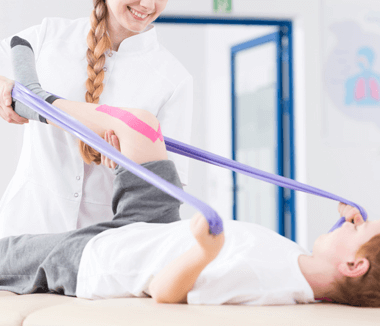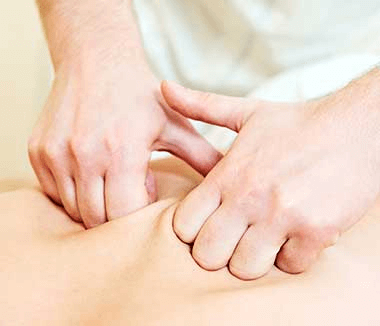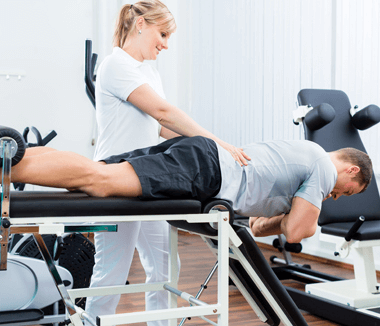See details
READ MORE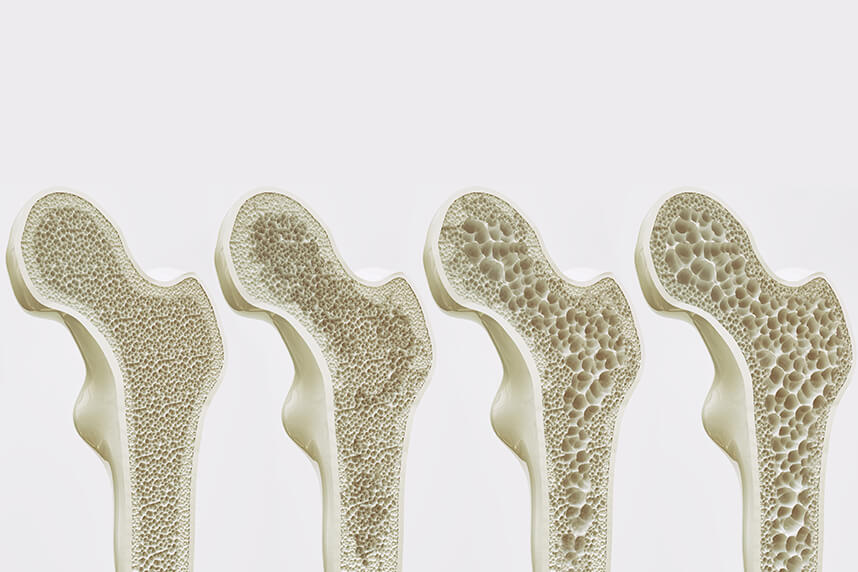
What awaits you at Centrokinetic?
Centrokinetic welcomes patients, having a complete rheumatology department, a medical branch that deals with the diagnosis, treatment, and recovery of patients with non-surgical musculoskeletal disorders. These conditions are usually painful, acute, or, most often, chronic, preventing the proper functioning of the musculoskeletal system. They are generally called rheumatism or rheumatic and musculoskeletal diseases.
Most of the times, the patient's evaluation is complex, multidisciplinary, considering the systemic, generalized character of most rheumatological diseases, that is why Centrokinetic has experienced doctors:
- Rheumatologists: Dr. Alizzi Khalid and Dr. Oana Olteanu.
- Medical rehabilitation doctors: Dr. Tache Georgiana, Dr. Edis Mustafa, Dr. Matei Adina, Dr. Czego Renata.
- Orthopedic doctors: Dr. Andrei Bogdan, Dr. Vlad Gican and Dr. Crintea Alexandru
- Radiologists: Dr. Pantu Cosmin and Dr. Ghiea Sorin
- Neurologists: Dr. Rotaru Bogdan, Dr. Simona Man and Dr. Simion Laurentiu
- Doctor of nutrition and metabolism diseases: Dr. Elian Viviana
What is osteoporosis?
Osteoporosis is a condition characterized by a decrease in bone density. Osteoporosis leads to an abnormal porous bone that is compressible, like a sponge. This skeletal disorder decreases bone strength and often leads to fractures, and sometimes low trauma intensities.
Osteoporosis means porous bone. Seen under a microscope, the healthy bone looks like a honeycomb. When osteoporosis occurs, the holes and spaces in the honeycomb are much larger than usual. Osteoporotic bones lose their density and contain abnormal tissue structures. As the bones become less dense, they weaken and are more likely to fracture. The spine, hips, ribs, and wrists are common areas of bone fractures from osteoporosis, although osteoporosis-related fractures can occur in almost any skeletal bone.
Causes
Osteoporosis occurs when there is an imbalance between new bone formation and old bone resorption. The main cause of osteoporosis is the lack of certain hormones, especially estrogen in women and androgen in men. Women, especially those over the age of 60, are frequently diagnosed with this disease. Menopause is accompanied by lower estrogen levels and increases a woman's risk of developing osteoporosis. Other factors that can contribute to bone loss in this age group include insufficient intake of calcium and vitamin D, lack of physical exercise, and other age-related changes in endocrine function (in addition to lack of estrogen).
The early stages of osteoporosis do not cause symptoms or warning signs. In most cases, people with osteoporosis do not know they have this condition until they have a fracture. If symptoms occur, some of the earliest may include:
- weak grip strength
- weak and fragile nails
Without proper treatment, osteoporosis can progress rapidly. As the bones become thinner and weaker, the risk of fracture increases. Later, during the illness, sharp pains may appear suddenly. The pain may not radiate (spread to other areas); it can be aggravated by an activity that puts weight on the area, it can be accompanied by increased sensitivity, and, generally, begins to decrease in a week. But, there are cases where the pain can last more than three months.
At Centrokinetic, Dr. Alizzi Khalid will perform a complete clinical examination. You may have muscle and joint pain, stiffness after rest, and decreased mobility. The doctor will also do a complete, vascular, and nervous examination of the affected limb.
Our medical team can complete the investigations to establish a correct diagnosis, with imaging investigations (musculoskeletal ultrasound, joint MRI), functional tests (electromyography), and arthrocentesis. Centrokinetic has a state- of-the-art MRI device, dedicated to musculoskeletal disorders of the upper and lower limbs. The MRI machine is open, so that people suffering from claustrophobia can do this investigation without any problems. The examination duration is, on average, 20 minutes.
Diagnostic
The osteoporosis diagnosis can be easily made by our doctors:
Traditional radiographs cannot measure bone density, but they can identify fractures of the spine. Bone mineral density must be measured by more specialized techniques. Several types of tests are available, but the most commonly used is DXA. It is used to measure the density of the bone in the spine and hip and can also measure the bone density of the entire skeleton.
Treatment
The most important parameter in osteoporosis is for the patient to move, because the bones are dynamic in structure, they react to physical stimuli. Centrokinetic has modern equipment for the treatment of osteoporosis: the Galileo vibration platform. The Galileo principle is based on the natural movement of human gait. Galileo's lateral oscillating motion is similar to a normal motion with varying amplitude and frequency and therefore generates a movement pattern similar to human gait. The rapid movement of the training platform causes a pelvic tilt movement, just like while walking, but much more frequently. To compensate, the body responds with rhythmic muscle contractions, alternating between the left and right sides of the body. At a frequency of about 10 hertz, these muscle contractions are not a conscious process, but rather a reflex. This stretching reflex activates the muscles of the legs, stomach, and back.
Bone metabolism is influenced by physical factors, so simulating gait with Galileo will lead to bone mass recovery. Find out more details about the Galileo board and the roles of this device here.
The natural supplements recommended by our doctors are:
- Magnesium (500 mg daily) - Magnesium is necessary for proper calcium metabolism.
- Calcium (1000 mg daily) - Choose calcium citrate that is best absorbed.
- Vitamin D3 (5,000 IU per day) - Vitamin D helps improve calcium absorption.
- Vitamin K2 (100 mcg per day) - It is needed to form protein critical for bone formation. Take high-quality vitamin K2 supplements, or eat more foods rich in vitamin K.
- Strontium (680 mg daily) - May help improving bone density.
The drugs are used both to prevent and treat osteoporosis. Some medications slow down the rate of bone loss and increase bone density. Medications that help treat and prevent bone loss include:
- Bisphosphonates. These include alendronate (Fosamax), ibandronate (Boniva), risedronate (Actonel), and zoledronic acid (Reclast).
- Calcitonin (Calcimar or Miacalcin). This is a natural hormone that helps regulate the level of calcium in your body and is part of the process of building bones. Calcitonin also relieves pain caused by compression fractures of the spine.
- Denosumab (Prolia). It is used to treat people who have an increased risk of bone fractures related to decreased bone density.
- Teriparatide (Forteo). It is used to treat men as well as postmenopausal women who have severe osteoporosis and are at increased risk of bone fractures.
- Raloxifene (Evista). This drug is a selective modulator of estrogen receptors.
- Hormone therapy is not usually recommended for most women with osteoporosis. But if you are at high risk and cannot take other medications, your doctor may recommend it in certain circumstances.
Nutrition is very important in osteoporosis. The goal is to eat meals that include a wide variety of foods from the four main groups. These are fruits and vegetables; carbohydrates such as bread, potatoes, pasta, and cereals; dairy and alternative products; beans, fish, eggs, meat, and other proteins. The food for your bones doesn't have to be boring; there are plenty of delicious meals and snacks full of vitamins and minerals you need.
- Eat plenty of whole foods, such as brown rice.
- Eat more fruits and vegetables; at least five servings a day. Choose different colored fruits and vegetables to make sure you have the range of essential nutrients you need, including calcium.
- Eat more fish; Try two servings a week and remember that fatty fish, such as mackerel, are also a good source of vitamin D.
- Reduce saturated fats and sugar. Check food labels: 5g or more of saturated fat per 100g and 10g or more of sugar per 100g means a lot.
- Try to reduce the amount of salt you consume. Again, check food labels and remember that 0.5g or more of sodium per 100g means a lot.
- Don't skip breakfast. If you are not hungry when you wake up, start with a healthy snack and eat regular meals throughout the day to maintain your health and well-being.
- Anti-inflammatory solutions or corticosteroids: are usually used for several types of musculoskeletal problems, such as tendinitis, tenosynovitis, bursitis, fasciitis, osteoarthritis, muscle injuries, ligament injuries. Corticosteroids are natural hormones made from cholesterol in the adrenal glands. In clinical practice, steroids are used for their powerful anti-inflammatory effects. Corticosteroids should not be confused with anabolic steroids, which are known to be used by athletes to increase muscle mass and strength. Corticosteroids used in resentment are injected all over the world, the administration doses are minimal, on average 0.4mg, and the side effects are similar in elderly patients, by temporarily increasing (2-3 days) blood pressure and blood sugar.
- Sterile viscoelastic solutions (hyaluronic acid): are performed mainly intraarticularly, both in the large joints (knee, shoulder, hip, ankle) and in the small ones (fist, elbow, metatarsophalangeal, or interphalangeal). The role of these infiltrations is multiple: protector of the articular cartilage through the viscous properties of the injection - the molecules of Hyaluronic Acid in the synovial fluid, act as a lubricant, protecting the articular surfaces from mechanical damage, by elastic properties - under the pressure generated by the joint load (bodyweight), hyaluronic acid in a synovial fluid acts as a shock absorber, protecting cartilage from compressive trauma, a nutrient for joint cartilage, synovial tissue protector: Hyaluronic acid is a protective barrier for the synovial membrane and masks the receptors for inflammation in the knee, reducing inflammation.
- Infiltrations with PRP (platelet hyperconcentrate): have been used since 1978 in the USA, in the treatment of musculoskeletal disorders, with extraordinary results. The infiltration lasts on average 40 minutes, is painless, and consists of collecting peripheral blood (from the vein) of the patient, on average between 60 and 180 ml, centrifugation 20-25 minutes to separate platelets from other blood cells, and injection into the same stage in the affected area. Centrokinetic offers patients treatments with the best PRP kits in the world, brought from the USA, from Arthrex and Magellan. The rationale for using this type of infiltration is to initiate and accelerate the natural process of tissue healing and regeneration by releasing platelet-derived growth factors directly into the affected tissue. According to current studies, soft tissue lesions and cartilage lesions are receptive to this treatment. Some of these include the following: tendinitis (epicondylitis, plantar tendonitis, Achilles, patellar, etc.), tendinosis, tendon ruptures, tendon degenerative lesions, muscle ruptures, cartilage lesions (arthrosis). The therapy also has a postoperative indication in meniscus suture, ligamentoplasty, sutures/tendon reinsertions (rotator cuff, Bankard, Achilles tendon, patellar tendon, quadrigeminal, etc.).
- Autologous growth factor therapy: is a therapy used in Germany for 15 years, and consists of harvesting the body's growth factors, multiplying them by incubation, and reinjecting them into the affected area. The duration of the treatment is 3 hours, performing 3-5 procedures, at 1-week intervals. The major indications are chronic tendinitis (epicondylitis, plantar tendonitis, Achilles, patellar), and articular cartilage lesions (arthrosis). It also has excellent results in the treatment of joint and periarticular pain. Autologous growth factor therapy is a treatment with a cytokine-rich autologous serum (ACRS), derived from the patient's blood. To ensure high tolerability, this technology completely avoids the use of any artificial additives. This special serum, rich in autologous cytokines, can activate the body's ability to heal itself by producing positive interleukins and growth factors. These are crucial to intervene in the cascade of pain, causing it to stop and the subsequent onset of the healing process.
Centrokinetic clinic has a very experienced team, specialized in sports traumatology, accredited in: Tecar therapy, dynamic taping, massage, Graston technique, Kinesio Tape, ERGON, flossing band. Our team has attended numerous overspecialized courses with trainers from the country and abroad, being certified to perform therapies at the highest level.
Our doctors advice: patients affected by this condition must prevent falling and fractures and they must exercise. It can be challenging to find a balance between taking care of your health and not becoming isolated, especially if that means avoiding activities and interests that are important to you. You can think about osteoporosis as a diagnosis that determines you to make informed decisions regarding your lifestyle and a treatment that will reduce the risk of getting fractures in the future. Massages, painkillers and rest may relieve osteoporosis symptoms.
About Centrokinetic
Centrokinetic clinic offers all services necessary for a complete rehabilitation process, from the first consultation to the medical specialist to establish the correct diagnosis, to treatment and recovery.
Centrokinetic is the place where you will find clear answers and solutions for your motricity problems. The clinic is dedicated to osteoarticular conditions and is divided into the following departments:
- Orthopedics, a department composed of an extremely experienced team of orthopedic doctors, led by Dr. Andrei Ioan Bogdan, primary care physician in orthopedics-traumatology, with surgical activity at Medlife Orthopedic Hospital, specialized in sports traumatology and ankle and foot surgery.
- Pediatric orthopedics, where children's sports conditions are treated (ligament and meniscus injuries), spinal deformities (scoliosis, kyphosis, hyperlordosis) and those of the feet (hallux valgus, hallux rigidus, equine larynx, flat valgus, hollow foot).
- Neurology, which has an ultra-performing department, where consultations, electroencephalograms (EEG) and electromyography (EMG) are performed.
- Medical recovery for adults and children, department specialized in the recovery of performance athletes, in spinal disorders, in the recovery of children with neurological and traumatic diseases. Our experience is extremely rich, treating over 5000 performance athletes.
- Medical imaging, the clinic being equipped with ultrasound and MRI, high-performance devices dedicated to musculoskeletal disorders, and complemented by an experienced team of radiologists: Dr. Sorin Ghiea and Dr. Cosmin Pantu, specialized in musculoskeletal imaging.
Find the latest news by following the Facebook, Instagram and YouTube accounts of the Centrokinetic clinic.
Recovery in pelvic disorders
Centrokinetic introduces the patients to the first concept in the recovery of pelvic disorders branch in Romania, Find out more about the investigation and the treatments available in this department.
READ MORERecovery from COVID-19
After healing of COVID-19, patients must make significant efforts to quickly return to everyday life. To meet these needs, Centrokinetic clinic created a program called "Recovery from COVID-19 infection."
READ MOREHyperbaric oxygen therapy
Hyperbaric therapy is a form of medical treatment that involves exposing the body to pure oxygen at a higher pressure than normal. There are about 45 diseases approved worldwide to be treated with hyperbaric oxygen.
READ MORERehabilitation in osteoporosis
Centrokinetic has modern equipment for the treatment of osteoporosis: the Galileo vibration platform. The Galileo principle is based on the natural movement of human gait.
READ MOREONCOLOGICAL REHABILITATION
Centrokinetic has a department that is specialized in the rehabilitation of oncologic patients. Physiokinetotherapy has a major contribution in increasing the life quality of oncologic patients, during and after disease.
READ MORENeurorehabilitation in Bucharest
Discover Centrokinetic's new Department dedicated to Neurological Conditions, where patients are offered complex services of neurological medical recovery.
READ MORECupping Therapy
With the help of suction cups, the skin, tissue and muscles are pulled up to increase circulation in the targeted areas and to provide pain management. Find out more about this treatment used today by internationally recognized athletes.
READ MOREPHYSICAL THERAPY
Depending on the problem, our physical therapists will use one of the 7 types of physical therapy, created on the basis of famous recovery protocols. Medical recovery for a broad spectrum of diseases, from chronic musculoskeletal diseases and post-traumatic recovery to orthopedic or neurosurgical post-surgery recovery. The programs are created by the clinic's doctors and include custom physical exercises, modern physiotherapy procedures, articular infiltrations. Click on the images and on the “See details” button for more information.
READ MOREPhysiotherapy and Physiokinetotherapy
Through physiotherapy we can treat almost any disease that affects the muscles, nerves or joints. Any procedure that takes place in our clinic starts with a medical examination followed by a diagnosis and recovery therapy program, adapted to every patient and affection, for the best results. For clients who buy any physiokinetotherapy package, the consultation is free.
READ MORETHERAPEUTIC MASSAGE
A combination of relaxation massage and remedial massage, the therapeutic message is necessary in order to relax muscles, improve muscle tone and flexibility.
READ MOREKINESIO TAPING ROCKFORD
The application of the kinesiological bands directly stimulates the peripheral and lymphatic circulatory system, and indirectly, the muscular and neurological systems.
READ MOREMANUAL THERAPY
Manual therapy restores the mobility of rigid joints and reduces muscle tension, to return the patient to the most natural movement possible, without pain.
READ MOREVERTEBRAL ELONGATIONS
Vertebral elongation is a physical maneuver that aims to temporarily widen the space between the vertebrae, in order to clear the intervertebral discs.
READ MORE
MAKE AN APPOINTMENT
CONTACT US
SUCCESSFUL RECOVERY STORIES
MAKE AN APPOINTMENT
FOR AN EXAMINATION
See here how you can make an appointment and the location of our clinics.
MAKE AN APPOINTMENT

